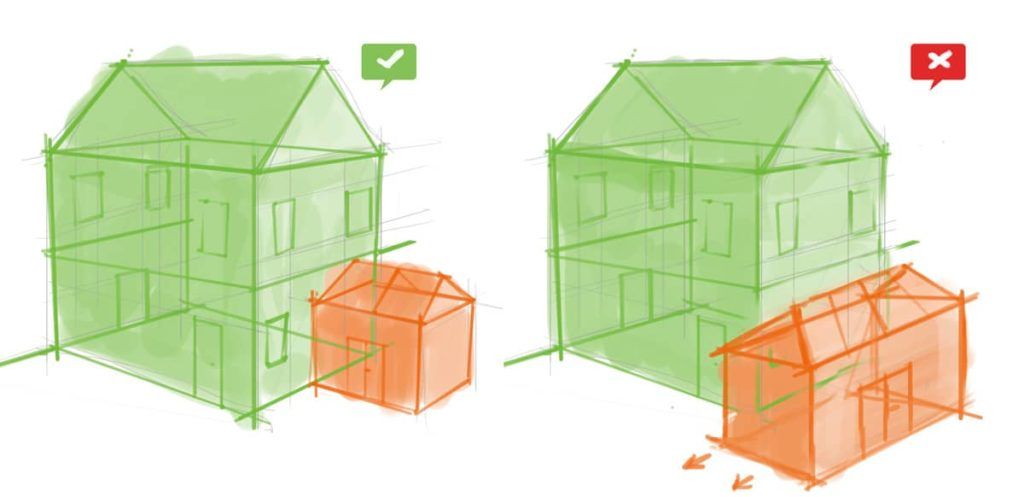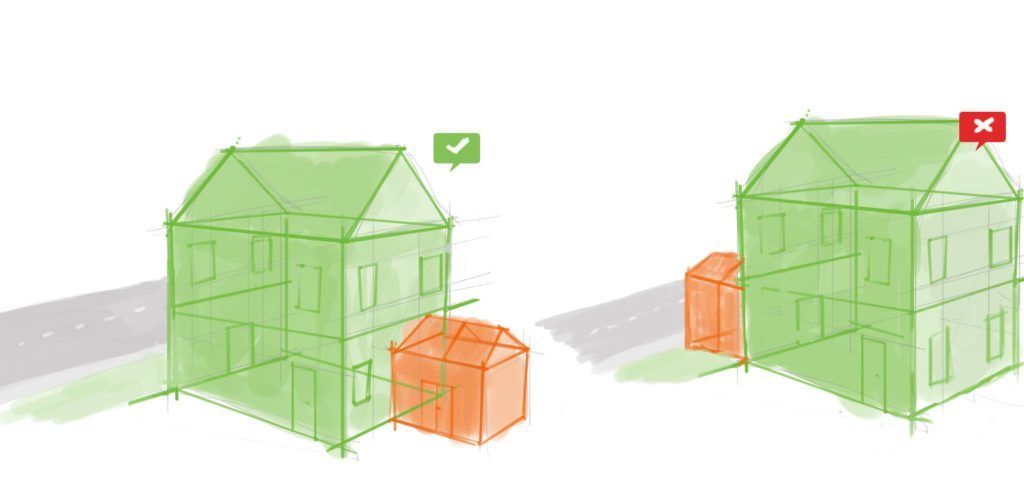A modern extension can do wonders for your home, but do you need planning permission for a conservatory, and how much could it cost?
It’s crucial to follow all building legislation, so you don’t face expensive errors. Read on to learn about conservatory planning permission, when it’s required, and how to apply for it.
Reviewed and updated in September 2024.
In this guide, we cover:
Do you need planning permission for a conservatory?
When is conservatory planning permission not required?
What is the 4 year rule for conservatory planning permission?
How large can a conservatory be without planning permission?
How close can you build a conservatory to a boundary?
Do you need planning permission for a conservatory on a semi-detached house?
When does a conservatory need planning permission?
How much does it cost to get planning permission in the UK?
Other planning permissions to consider
Do you need planning permission for a conservatory?
You don’t need planning permission, provided your conservatory meets certain conditions. Conservatories that comply with the permitted development regulations allow you to build without planning permission. However, if your extension exceeds these conditions, you’ll likely need to apply for conservatory planning permission.
Bear in mind that planning permission is separate from building regulations, and you
should consider both legislations.
When is conservatory planning permission not required?
There are several rules to meet that will allow you to extend your home with a conservatory without planning permission.
Let’s outline some of the conditions below.
1. The conservatory walls run within the length of the property’s walls
If any part of the conservatory extends beyond the wall of your home, then you will need to apply for planning permission. See the diagram below.

2. The conservatory covers less than 50% of your land area
Conservatories should not take up more than half of the total land area surrounding the original house (the state of the property when it was first built or as it stood on 1st July 1948 if it was built before that date).
When calculating this figure, take into account any land on your property that isn’t your residence. This includes your front and back gardens and any side passages you own. Calculate the total area and make sure your conservatory and other outbuildings (such as sheds or garages) do not exceed half of it. For example, if the total land area around your original house is 20 square metres, your conservatory and any other outbuildings cannot exceed 10 square metres.
3. The conservatory’s height is lower than the house’s roof
Your conservatory shouldn’t exceed the height of your roof.
A significantly large extension could violate this condition if you live in a single-storey property, like a bungalow. If this is the case, consider a small conservatory instead to avoid applying for planning permission approval.
4. The conservatory does not face onto a road
If you’re planning on building a conservatory on the front or side of your property, it shouldn’t be closer to a public road or footpath than your main residence.

5. A single-storey rear extension height doesn’t exceed four metres
If you’re building a single-storey conservatory at the rear of your property, it shouldn’t exceed four metres in height.
6. A single-storey side conservatory doesn’t exceed half the width of your home
A single-storey conservatory on the side of your home should not exceed four metres in height or a width of more than half of the original house.
To calculate this figure, determine the width of your original house and then half it. For example, if the original house is six metres wide, the side extension cannot exceed three metres in width.
7. The conservatory doesn’t exceed a certain depth
A single-storey rear conservatory can extend beyond the rear wall of the original house up to eight metres for a detached house and six metres for terraced or semi-detached properties.
8. The eaves should not be higher than the house’s eaves
This condition applies to the eaves and ridges of your conservatory. The maximum eaves height should not exceed the existing house’s. The highest point of the conservatory should also not be higher than the existing house’s roof ridge line.
9. The eaves do not exceed three metres in height
Any conservatory within two metres of the edge of your property (where the land you own ends) shouldn’t have eaves higher than three metres from the lowest point on the ground.
10. The extension does not include balconies, raised platforms or verandas
This limit states that your conservatory cannot have balconies or other raised platforms.
At ConservatoryLand, we don’t typically manufacture conservatories with any of these features (unless requested). You will need planning permission if you wish to add them.
11. The conservatory’s roof pitch higher than one storey matches the house
The steepness of a house’s roof is measured by its roof pitch. If your conservatory is more than one storey tall, the roof pitch must match the house’s roof.
If you have any doubts about whether your conservatory would be considered a permitted development, contact your local planning authority before starting construction.
What is the 4 year rule for conservatory planning permission?
The 4-year rule offers a potential way to avoid retroactive planning permission. If your conservatory has been in place for four years without enforcement action, it becomes immune from legal repercussions, even if built without proper conservatory planning permission. However, it does not apply if it violates building regulations.
How large can a conservatory be without planning permission?
To avoid needing planning permission, a conservatory must cover less than 50% of the total area surrounding your home. The height and width restrictions depend on your property’s size and other conservatory rules.
How close can a conservatory be to a boundary?
It’s important to consider your boundaries when planning your conservatory project, especially if you live in an area with many nearby properties.
The rules outlined by Planning Portal state that if a conservatory is within two metres of a boundary, its eaves height must be no more than three metres to qualify as permitted development. If the height exceeds three metres, planning permission will likely be required. You can build within two metres of the boundary as long as the boundary itself isn’t disturbed, ensuring the structure doesn’t affect privacy, block daylight, or encroach on neighbouring properties.
If you’re concerned about the distance between the perimeter of your conservatory and
your neighbouring boundary, seek the advice of your local planning authority before you
proceed with the build.
Do you need planning permission for a conservatory on a semi-detached house?
For semi-detached homes, conservatory permitted development rules apply. The side facing the adjoining property must meet specific conditions, such as the height limit near boundaries. This ensures that building a conservatory does not impact neighbouring properties. If your build violates any of these conditions, you’ll need to seek permission.
When does a conservatory need planning permission?
You’ll need planning permission for a conservatory if it doesn’t meet permitted development conditions. These conditions may not apply in some areas like conservation zones, where restrictions on building work may require a formal application. If Article 4 restrictions apply, it’s important to consult your local planning authority.
How much does it cost to get planning permission in the UK?
You need to submit an application to obtain planning permission. The application fees vary in England and Wales, so you should check with your local authority.
Typically, you’ll receive an answer within eight weeks of submitting your application. In some cases, it could take up to 13 weeks.
Find out more information about applying for planning permission on the GOV.UK website.
Other planning permissions to consider
It’s essential to check whether your conservatory needs planning permission before starting construction.
Find more information in our other guides on planning permission:
- Planning permission for Orangeries
- Planning permission for conservatories built pre-2008
- Planning permission for conservatories on bungalows
- Planning permission for conservatories with tiled roofs
- Planning permission for conservatories with a radiator
- Planning permission for conservatories with a log burner
Looking for a conservatory provider? Here at ConservatoryLand, we create bespoke conservatories made to measure based on your specifications. Get your free personalised quote online. And if you’d like to learn more, give us a call. Our team is on hand to answer your questions, from planning permission concerns to conservatory design queries.
FAQs
What is a permitted development?
Planning permission is the formal approval required from a local authority to build or modify a property. It ensures that any proposed construction or changes meet local regulations and do not negatively impact the surrounding area. This process helps manage development in a way that balances growth with the protection of the environment and community interests.
What is the difference between planning permission and building regulations?
Planning permission and building regulations serve different purposes in construction.
Planning permission focuses on the overall development, ensuring the building or extension fits with local plans and doesn’t negatively affect the surrounding area. It considers aspects like appearance, size, environmental impact, and how the project blends with the neighbourhood.
Building regulations, on the other hand, set the technical standards for the safety, health, and structural integrity of the construction. These rules cover areas like fire safety, insulation, electrical wiring, and drainage to ensure the building is safe and energy-efficient.
In short, planning permission deals with what you can build and where, while building regulations govern how it should be built. Both may be required for certain projects. Find out more about conservatory building regulations here.
What is a permitted development?
If certain limitations and conditions are met, rules known as permitted development rights allow you to extend a house without needing to apply for planning permission.
If your conservatory extension does meet the relevant conditions, it would be described as a permitted development.
What are the planning permission rules for listed buildings or designated land?
If you plan to make changes to a listed building, including adding a conservatory, you’ll need Listed Building Consent. There are also areas under more limited rights, including conservation areas and national parks.
Designated land is also subject to restrictions, and one condition states that cladding cannot be used on the exterior of the conservatory.
What is the neighbour consultation scheme?
Generally, where the conservatory plans indicate that the development is close to the boundary, you will need to consult the neighbour consultation scheme.
This scheme differs from planning permission approval. The local authority scheme consults the adjoining neighbours to advise them about the development. This gives the neighbouring property the opportunity to object to the plans and work towards a clear resolution with the local council, which will ultimately decide whether the development should go ahead. This applies to both conservatories that are permitted developments and extensions that require planning permission.
The neighbour consultation scheme is an important consideration for semi-detached property developments because the extension can often impact the neighbouring property. This could be due to a light obstruction or a privacy issue.
Disclaimer
Please note that the information provided on this page is not legal advice. It is given as a guide only, based on the information outlined at planningportal.co.uk.
The guidance described on this page applies to houses, not flats, maisonettes or other buildings. Other consents may also be required if your home is listed or in a designated area.
The information was correct at the time of publication, but it is subject to change as a result of legislative changes. Before beginning any work, always seek advice from local planning authorities.